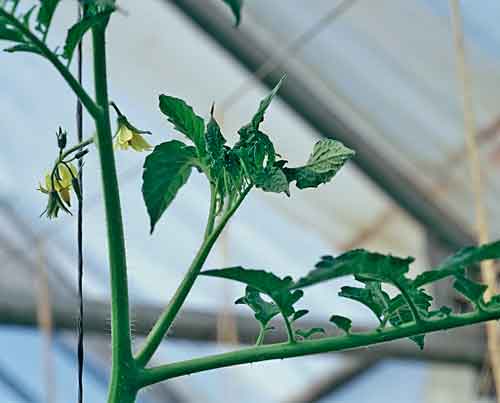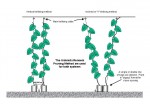Pruning tomatoes – a simple neglected task
Pruning tomatoes is an essential activity during the maintenance of the tomato crop. Just as the plants should be trellised every week, so should each tomato plant be pruned in order to obtain maximum yields. Pruning tomatoes ensures that the energy is used in developing fruit and the main stem. The pruning and trellising (also referred to as “training”) activities are quite often the first to lag behind as soon as harvesting starts. This results in plants that look neglected due to suckers growing out of the main stem and the growth point growing far above the main trellising wire. Neglecting these two activities can result in reducing yields of up to 50%.
Determinate tomato plants do not have to be pruned or trellised. They are designed to grow a limited period after which the die. The indeterminate types must be pruned and trellised otherwise yields will be reduced considerably. The best method is to prune indeterminate types to one stem, thus removing all suckers (also referred to side shoots). Suckers are small growth points that develop into a stem with leaves and more tomato trusses. They can be located between the stem and a leaf axil. Leaving the sucker to long can result in a reduction of at least 10% in total yields.
The ideal length of the sucker is between 50-70 mm. At this length they can easily be broken of by hand without injuring the stem or the leaf under it. If the sucker is smaller it is difficult to brake of. The importance of removing suckers are:
- Side shoots are removed in order to maintain one stem
- Must be removed when smaller than 70 mm
- Side shoots must be removed weekly
- Never use finger nails to remove side shoots
- Side shoots should be broken of by hand and not cut of by scissors
- Suckers forming at the base of the plant should be removed

Pruning tomatoes: Shoots must be removed close the base of the plant. Early removal of side shoots allows for more energy available for fruit development.
Many experts and growers are of the opinion that the removal of the lower leaves will have a negative effect on production. This however has never been experimentally proved. There are more negative influences than positive in keeping the lower leaves on the plant. The reasons for removing the lower leaves are:
- Leaves that are old and that have turned yellow are susceptible to diseases
- Removal of leaves makes harvesting easier
- Leaves covering the truss that will be harvested the following week should be removed
- The removal of leaves increases air movement in the tunnel and reduces disease development
- Remove the leaves every second week
- Do not remove more than two leaves
It is important that removed leaves should not be left inside the tunnel for longer than a day and the dead leaves should either be burnt or placed far from the production site. There should be at least 1.5 m of healthy leaves left on the plant. When removing leaves, they should be bent upwards first, then pulled down in order to prevent the epidermis (“skin”) of the stem pealing of and exposing a view centimetres of the stem to diseases. Never use a knife or scissors to remove leaves since this just help in spreading diseases.



